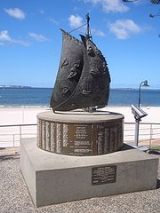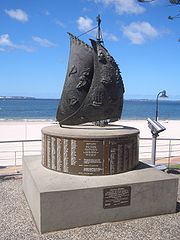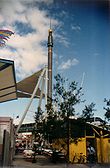
Australian Bicentenary
Encyclopedia
The bicentenary of Australia was celebrated in 1970 on the 200th anniversary of Captain James Cook
landing and claiming the land, and again in 1988 to celebrate 200 years of permanent Europe
an settlement.
 The bicentenary of Captain James Cook
The bicentenary of Captain James Cook
's arrival and claiming of the east coast of Australia in 1770. The name of the place on which he is believed to have made first landfall was renamed from Cape Everard back to the name Cook had given it, Point Hicks
.
's arrival with the 11 ships of the First Fleet
in Sydney Harbour in 1788, and the founding of the city of Sydney
and the colony of New South Wales
.
 The Australian Bicentennial Authority (ABA) was setup to plan, fund and coordinate projects that emphasized the nation's cultural heritage. State Councils were also created to ensure cooperation between the federal and state governments. The result was a national programme of events and celebrations to commemorate the Bicentenary, including:
The Australian Bicentennial Authority (ABA) was setup to plan, fund and coordinate projects that emphasized the nation's cultural heritage. State Councils were also created to ensure cooperation between the federal and state governments. The result was a national programme of events and celebrations to commemorate the Bicentenary, including:
The opening ceremony of the 16th World Scout Jamboree
, which took place at midnight on 31 December 1987, was the first official event of Australia's Bicentenary.
1988 was also marked by the completion of many unique development
projects such as the Bicentennial National Trail
and on 9 May of that year, Queen Elizabeth II
opened the New Parliament House
in Canberra
. As well as this, the modern Darling Harbour precinct was completed & opened, as was the modern Sydney Football Stadium. It was also marked by the creation of one of Australia's most significant art works, the Aboriginal Memorial
, which commemorated those Indigenous Australians who died as a result of European settlement.
Significant improvements to Australian roads were made through the Australian Bicentennial Road Development Program.
James Cook
Captain James Cook, FRS, RN was a British explorer, navigator and cartographer who ultimately rose to the rank of captain in the Royal Navy...
landing and claiming the land, and again in 1988 to celebrate 200 years of permanent Europe
Europe
Europe is, by convention, one of the world's seven continents. Comprising the westernmost peninsula of Eurasia, Europe is generally 'divided' from Asia to its east by the watershed divides of the Ural and Caucasus Mountains, the Ural River, the Caspian and Black Seas, and the waterways connecting...
an settlement.
1970

James Cook
Captain James Cook, FRS, RN was a British explorer, navigator and cartographer who ultimately rose to the rank of captain in the Royal Navy...
's arrival and claiming of the east coast of Australia in 1770. The name of the place on which he is believed to have made first landfall was renamed from Cape Everard back to the name Cook had given it, Point Hicks
Point Hicks
Point Hicks, formerly called Cape Everard, is a coastal headland on the eastern coast of Victoria, Australia, located within the Croajingolong National Park.- Name :...
.
1988
The bicentennial year of Captain Arthur PhillipArthur Phillip
Admiral Arthur Phillip RN was a British admiral and colonial administrator. Phillip was appointed Governor of New South Wales, the first European colony on the Australian continent, and was the founder of the settlement which is now the city of Sydney.-Early life and naval career:Arthur Phillip...
's arrival with the 11 ships of the First Fleet
First Fleet
The First Fleet is the name given to the eleven ships which sailed from Great Britain on 13 May 1787 with about 1,487 people, including 778 convicts , to establish the first European colony in Australia, in the region which Captain Cook had named New South Wales. The fleet was led by Captain ...
in Sydney Harbour in 1788, and the founding of the city of Sydney
Sydney
Sydney is the most populous city in Australia and the state capital of New South Wales. Sydney is located on Australia's south-east coast of the Tasman Sea. As of June 2010, the greater metropolitan area had an approximate population of 4.6 million people...
and the colony of New South Wales
New South Wales
New South Wales is a state of :Australia, located in the east of the country. It is bordered by Queensland, Victoria and South Australia to the north, south and west respectively. To the east, the state is bordered by the Tasman Sea, which forms part of the Pacific Ocean. New South Wales...
.

- Australia LiveAustralia LiveAustralia Live was a four hour telecast, broadcast live on Channel Nine, on 1 January 1988 to open Australia's Bicentennial celebrations. The telecast crossed live to over 70 locations right across the country to represent a 'typical' day in the life of the Australian people...
, a television special on New Year's Night. - The arrival of the First FleetFirst FleetThe First Fleet is the name given to the eleven ships which sailed from Great Britain on 13 May 1787 with about 1,487 people, including 778 convicts , to establish the first European colony in Australia, in the region which Captain Cook had named New South Wales. The fleet was led by Captain ...
Re-enactment Voyage in Sydney Harbour on Australia DayAustralia DayAustralia Day is the official national day of Australia...
. - World Expo 88 in BrisbaneBrisbaneBrisbane is the capital and most populous city in the Australian state of Queensland and the third most populous city in Australia. Brisbane's metropolitan area has a population of over 2 million, and the South East Queensland urban conurbation, centred around Brisbane, encompasses a population of...
, the largest event of these celebrations. - Australian Bicentennial Exhibition, toured throughout Australia
- all Australian schoolchildren were presented with a Bicentennial "Heritage Medallion"
- the issue by the NSW Roads and Traffic AuthorityRoads and Traffic AuthorityThe Roads and Traffic Authority is a former New South Wales government agency that was responsible for major road infrastructure, licensing of drivers, and registration of motor vehicles. The RTA directly managed State roads and provided funding to local councils for regional and local roads...
(from late 1987 to the end of 1988) of over 160,000 commemorative Bicentennial number plates which were sold at a premium. - the painting of A classV/Line A classThe A class are a group of bulldog nosed diesel electric locomotive delivered to V/Line between 1982 and 1984. Totalling 11, they are now divided up between passenger operator V/Line and freight operator Pacific National.-History:...
locomotive A66 by regional Victorian train operator V/LineV/LineV/Line is a not for profit regional passenger train and coach service in Victoria, Australia. It was created after the split-up of VicRail in 1983. V/Line is owned by the V/Line Corporation which is a Victorian State Government statutory authority...
in a unique green and gold livery featuring the official ABA Bicentennial Logo and the wording '1788 Australian Bicentennary 1988'. - Aus Steam '88Aus Steam '88Aus Steam '88 was an Australian Bicentenary activity in Melbourne, Victoria featuring many steam locomotives from NSW, Victoria and also the United Kingdom. The event took place at Spencer Street railway station, Melbourne from 15 October - 29 October...
, a railway display of steam locomotives at Spencer Street Station.
The opening ceremony of the 16th World Scout Jamboree
16th World Scout Jamboree
The 16th World Scout Jamboree was held 30 December 1987 to 7 January 1988, the first World Scout Jamboree held in the Southern Hemisphere, and the first to change the date from the traditional August to January to coincide with summer...
, which took place at midnight on 31 December 1987, was the first official event of Australia's Bicentenary.
1988 was also marked by the completion of many unique development
Urban planning
Urban planning incorporates areas such as economics, design, ecology, sociology, geography, law, political science, and statistics to guide and ensure the orderly development of settlements and communities....
projects such as the Bicentennial National Trail
Bicentennial National Trail
The Bicentennial National Trail , formerly known as the National Horse Trail is the longest marked multi-use trail in the world, stretching 5,330 kilometres from Cooktown, through New South Wales to Healesville, 60 km north-east of Melbourne...
and on 9 May of that year, Queen Elizabeth II
Elizabeth II of the United Kingdom
Elizabeth II is the constitutional monarch of 16 sovereign states known as the Commonwealth realms: the United Kingdom, Canada, Australia, New Zealand, Jamaica, Barbados, the Bahamas, Grenada, Papua New Guinea, the Solomon Islands, Tuvalu, Saint Lucia, Saint Vincent and the Grenadines, Belize,...
opened the New Parliament House
Parliament House, Canberra
Parliament House is the meeting facility of the Parliament of Australia located in Canberra, the capital of Australia. The building was designed by Mitchell/Giurgola Architects and opened on 1988 by Elizabeth II, Queen of Australia...
in Canberra
Canberra
Canberra is the capital city of Australia. With a population of over 345,000, it is Australia's largest inland city and the eighth-largest city overall. The city is located at the northern end of the Australian Capital Territory , south-west of Sydney, and north-east of Melbourne...
. As well as this, the modern Darling Harbour precinct was completed & opened, as was the modern Sydney Football Stadium. It was also marked by the creation of one of Australia's most significant art works, the Aboriginal Memorial
Aboriginal Memorial
The Aboriginal Memorial is a work of contemporary Indigenous Australian art from the late 1980s, and comprises 200 decorated hollow-log coffins. The coffins were created by 43 artists from Ramingining and neighbouring communities of Central Arnhem Land, in the Northern Territory...
, which commemorated those Indigenous Australians who died as a result of European settlement.
Significant improvements to Australian roads were made through the Australian Bicentennial Road Development Program.

